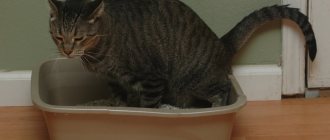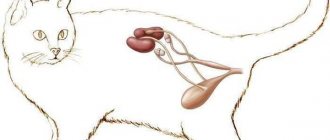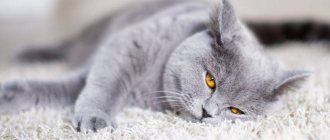Why do my ears smell bad?
Unpleasant odor from a cat's ears can be caused by the following factors:
- Suppuration that occurs against the background of traumatic injuries. Often, pets independently scratch the inside of the auditory organs when they are scratched, and fights are not excluded. When the infection gets into the ear, there is brown discharge with pus, a bad odor and a deterioration in the general condition of the cat, possibly an increase in body temperature.
- An inflammatory process caused by various liquids entering the hearing organ. Mostly, water ends up in them due to the carelessness of cat owners while bathing.
- Skull trauma. Impacts can cause bleeding and inflammation in the ears. As the blood accumulates, it becomes infected and the ear becomes inflamed. In addition to the smell of rotten meat, you can notice pus.
- Otitis. It is an inflammatory process in the ear, as a result of which animals experience discharge from the auditory organs, loss of appetite, and an unpleasant odor. It is important for the owner not to ignore these symptoms, since the pathology can cause a serious deterioration in hearing function or lead to complete deafness in the affected ear.
- Ear mite. The disease is often caused by the superficial sarcoptoid mite Otodectes cynotis. During the course of the disease, an inflammatory process occurs, which is sometimes complicated by infection, as a result of which stink is observed from the ear.
- Allergy. Mostly allergic reactions to foods are detected in cats, but medications, care products, and pollen can also act as allergens.
- Neoplasms. If your kitten's ear stinks, this symptom may be the first sign of a malignant or benign tumor developing in the auditory organs.
Treatment
Therapy depends on the diagnosis. Treatment must be comprehensive and includes hygiene procedures, medications, diet, and is carried out in three stages:
- Cleaning the ear canals.
- Taking medications prescribed by a veterinarian.
- Strengthening the immune system.
Hygiene procedures begin with cleaning the ear canal. For this purpose, special lotions are used that have anti-inflammatory and antiseptic effects.
The product is dripped into the ear and lightly massaged. Contaminants come out with excess liquid. Then gently wipe the skin with a cotton pad.
At this moment, the cat may shake its head and twitch its ear - this is a normal reaction. In this way, he gets rid of the fluid that bothers him, and the auricle is cleansed.
Medications
Drops are used to treat otitis media. They have antibacterial, anti-inflammatory and analgesic effects.
Drops aimed at treating otitis media in cats:
- Surolan . Antimicrobial and antifungal drug. Place 3-5 drops into each passage. Before use, a hygienic procedure is carried out to clean the passages. The course of treatment is no more than 2 weeks.
- Aurikan . Combined product for pets. Cats weighing up to 1.5 kg are prescribed 5 drops once a day. The course of treatment is no more than 7 days.
Most drops are suitable for getting rid of ear mites, as they have a wide range of effects. During the treatment period, special attention is paid to the cleanliness of the ear canal. Hydrogen peroxide is used for rinsing.
In case of allergic reactions, antihistamines for animals are used . In addition to therapy, it is recommended to eliminate allergens and follow a diet.
Antihistamines:
- Suprastin;
- Diazolin;
- Tavegil;
- Fenistil.
Tablets or drops are given to the pet 2 times a day. Only a veterinarian can prescribe the drug. You cannot self-medicate your cat.
To boost the immune system use:
- Salmozan;
- Glycopene;
- Gamaprene.
The drugs strengthen the pet’s immunity and supply the body with vitamins. This allows you to avoid the development of fungal infections, colds, and otitis media.
In case of head injury, therapy is carried out in a hospital under the supervision of specialists and is aimed at restoring the central nervous system and brain.
Traditional methods
Traditional methods are used in combination with drug treatment and in cases where it is not possible to consult a veterinarian.
Folk remedies:
- To cleanse the ear canal, green tea is used, which is dripped into the ear canal. After this, the auricle is lubricated with almond or lavender oil and a light massage is given.
- Instill chamomile decoction. It cleans the passage and relieves inflammation. Then drop in mint oil diluted with water in a 1:1 ratio. It has a bactericidal effect.
- Garlic and oil ointment. To prepare, take 1 tbsp. l. vegetable oil and 1 g of chopped garlic, mix thoroughly. Lubricate the ear once a day. The ointment has an antiseptic effect.
- Geranium juice is used against otitis media. The fresh leaf is ground into a paste and the juice is squeezed out. Using a pipette, drop 1 drop into each ear.
If itching and redness occurs, treatment should be stopped.
Prevention
To prevent odor from appearing in your animal’s ears, you need to monitor your pet’s health and diet. Hygiene procedures are carried out once a month, this is especially important for fold-eared breeds.
Cleaning procedure:
- Wrap the animal in a towel to avoid scratches.
- Moisten a cotton swab with lotion or hydrogen peroxide.
- Gently clean the ear canal.
- Wipe the inner surface with a dry cotton pad.
It is necessary to monitor the diet of cats prone to allergies. Food should be balanced . If the animal eats from the “common table”, fatty meat, cheese, and smoked products are excluded. The best solution would be to switch to hypoallergenic dry and wet food.
For preventative purposes, the pet is shown to a veterinarian every 6 months. This allows you to eliminate any diseases that cause unpleasant odors from the ear canal.
You should not leave your cat in a draft - this provokes the development of otitis media. Walking outside is only possible in warm weather.
Associated symptoms
The animal may often rub the outer part of the auditory organ with its paw.
In addition to the fact that the cat’s ears begin to stink, the owner of a pet may notice the following undesirable symptoms:
- rubbing the auditory organs with a paw;
- redness of the inside of the ear;
- loss of appetite;
- general increase in body temperature;
- apathy or irritability;
- constant meowing;
- rashes on the skin.
A head hematoma is a possible cause of ear rot.
With mechanical stress on the auricle, which includes insect bites, strong scratching or other destructive influences, it can be affected, which also causes ear rot.
If you do not consult a doctor in time, the consequences for the animal can be very dire, because the cat can inflict even greater injuries on itself, experiencing discomfort from rotting in the ears.
With such a diagnosis, treatment will not be difficult if action is taken promptly. If less than two days have passed since the injury to the auricle, the owner of the animal needs to apply cold to the affected area and make a special bandage. After 24 hours, you need to reverse the procedure - apply heat and apply a soothing ointment.
If self-medication does not produce results, you need to take your pet to a veterinarian, who will take the necessary measures and tell you how to properly treat the cat.
Diagnostics
If a cat has a bad ear odor, it is important for owners to take the animal to a veterinary clinic as soon as possible. At the appointment, the veterinarian will conduct a survey of the owner, during which he will find out how long ago the bad smell appeared and whether additional symptoms are present. The doctor then begins to examine the ears using an otoscope. Next, the sick animal is prescribed a general blood test, as well as an ear smear. If necessary, a biopsy is prescribed, during which a piece of tissue from the auditory organ is removed.
Diagnosis and treatment
If the owners notice that their furry pet has an earache, he often shakes his head, scratches his ears, eats poorly or refuses food altogether, becomes lethargic, inert, does not play at all, and reacts unusually aggressively to an attempt to touch the ear, screaming loudly, hisses, in a word, behaves completely inappropriately - this is a direct indication to urgently place the cat in a carrier and take him to the veterinary clinic. There the doctor will check the condition of the ears, take a swab, and examine his body.
If he detects discharge from the ear, the presence of an inflammatory process, traces of claws or bites on the animal’s body, inflammation of the inguinal lymph node, increased body temperature and other symptoms, he will prescribe special medications that, in case of severe disease, will be administered to the cat in a hospital hospital setting.
In cases where the owners sought help in a timely manner and the disease is in its early stages, the veterinarian will prescribe the necessary medications and prescribe the correct treatment.
It must be comprehensive. First of all, eliminate the irritant as much as possible. For example, in case of food allergies, it is necessary to identify the source of the disease and transfer the cat to a healthy, harmless diet.
For other diseases, after receiving test results, the doctor prescribes specific treatment, which must be carried out strictly according to his instructions.
How is the treatment carried out?
General recommendations
Part of the treatment of the disease is cleansing the auditory organs with peroxide.
The treatment regimen is directly related to the factor that provoked the stench from the cat’s ear. When the inflammatory process is accompanied not only by a bad odor, but also by suppuration, pet owners will need to cleanse the ear organ of pus daily. To carry out the procedure, you will need to follow the following algorithm of actions:
- Get rid of fur from the inside of the ear.
- Using a cotton swab and disinfectant solutions, clean the ear from discharge. It is recommended to use hydrogen peroxide.
- Dry the ear. It is permissible to use gauze, a bandage or a napkin, carefully blotting the organ.
After these manipulations, you need to resort to the help of medications prescribed by the veterinarian. For example, if a cat is diagnosed with otitis media, medications are prescribed that have a bactericidal, anti-inflammatory, anesthetic, antimycotic effect. Ear drops "Aurikan" and "Surolan" are often used. You will need to instill medications into both ears, even in a situation where only one is affected.
The right approach to nutrition
It is important that the animal eats vegetables during illness.
During therapy, the pet owner will need to monitor its diet. It is important to include food in the menu that is well digestible and contains a sufficient number of microelements and vitamins. It is recommended to feed cats lean meats, vegetables, rice and buckwheat, chicken and quail eggs. Once a week it is permissible to pamper your cat with boiled fish and fermented milk products. As for industrial feeds that are sold in stores, veterinarians from the Zoovet clinic recommend abandoning them during therapy. Such precautions are due to the fact that allergens may be present in their composition.
It is permissible to return to ready-made food only after the source of allergic reactions in the cat has been accurately identified.
Hematoma
One form of blood blister may occur in your cat's ear. It appears between the layers of the ear when the animal begins to scratch the ear. Blood from damaged vessels forms clots, which are usually removed either through surgery or through gentle treatment with special ointments. The course of their application to the affected area is several weeks.
Often a hematoma is formed due to mechanical damage. If you practice free-range with your pet, you should always be on guard. An animal can seriously damage not only the ear, but also other organs, for example, in a fight with relatives or dogs, when falling from a great height, or after being hit by a vehicle.
However, sometimes a hematoma is formed due to a pre-existing disease, such as otitis media, fungal infection of the ear, the already mentioned otodectosis and others. Infectious and parasitic diseases cause cats to scratch non-stop, resulting in self-injury.
Preventive actions
To prevent an unpleasant aroma from a cat’s ears, it is important for the pet owner to systematically examine his hearing organs. At least once a week you will need to clean your ears using special liquids and cotton swabs. The cat's owner also needs to ensure that she does not spend time in drafts. When bathing, it is recommended to insert cotton balls into your pet's ear to prevent water from getting into them.
After the bath, the animal should be in a warm room. If necessary, the cat can be carefully dried with a hairdryer. An important preventive measure is diet control. If the owner prefers to give the cat ready-made industrial food, it is imperative to take into account its composition and expiration date. When choosing complementary foods, you need to pay attention to the gender, age and health status of your pet.
Prevention
Prevention of the disease consists of monthly examination of the ear canals and preventive removal of accumulated wax. According to the anatomical features of the structure of shells in Sphinxes, Siamese, and Orientals, they are treated weekly.
One of the reasons for the development of otitis media is an allergic response to food. Housewives who treat their pets with food that is unusual for cats, as well as those who abuse vitamin supplements, are to blame. An excess of biological catalysts is more harmful than hypovitaminosis. The optimal solution is to use premium professional feed.
Timely disinsection prevents the proliferation of ectoparasites, as well as ear mites. The latter are activated when the immune system is weakened, so timely vaccination will protect the cat from viral infections and arthropod parasites.
Bathing causes a lot of anxiety. The animal does not need water treatments, but cat owners think differently. To prevent liquid from getting into the ear canals, you need to insert cotton plugs before bathing, and do not forget to remove them after the procedure.
Regular ear cleaning prevents ear infections
Necrosis of the ears.
In case of penetration of pathogenic microflora into the animal’s body, or subsequent strong compression, necrosis of the auricles may occur.
If you do not pay attention to the ongoing process in time, the area of decay can increase significantly, due to which the ear cartilage can rot and become deformed.
In this case, treatment involves complete amputation of the auricle, or part of it, and is carried out only by surgical intervention.











